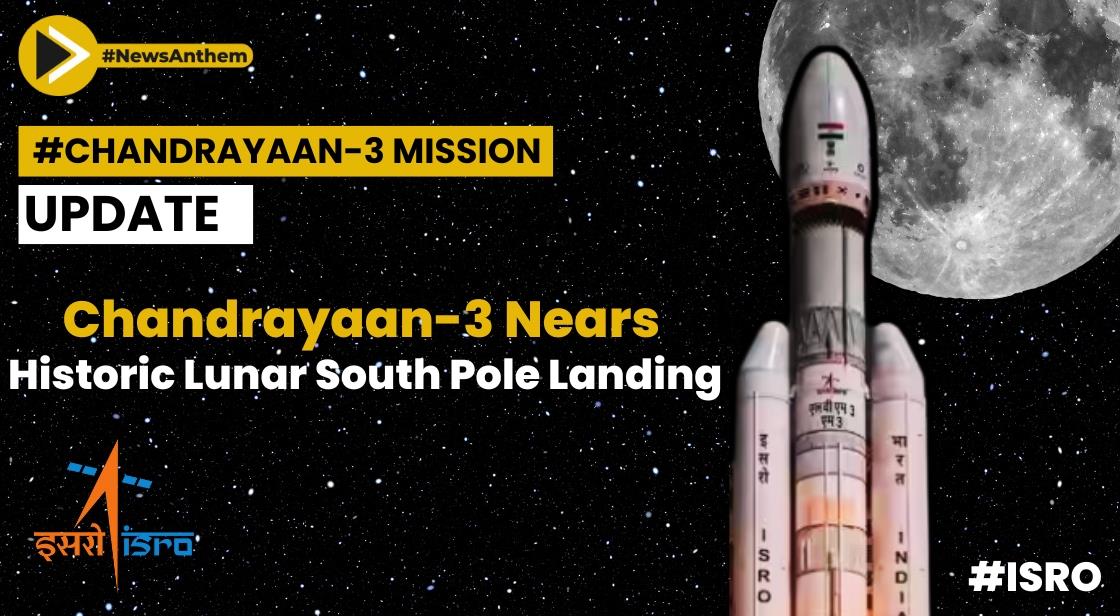Chandrayaan-3: On the Verge of a Historic Lunar Landing at the South Pole

News Synopsis
The Indian Space Research Organisation (ISRO) is on the brink of a momentous accomplishment as Chandrayaan-3's Lander Module (LM) prepares for a groundbreaking touchdown on the lunar surface.
This endeavor aims to make India the fourth country in history to achieve a successful lunar landing, with the added distinction of being the first to reach the uncharted south pole of Earth's celestial companion.
The Countdown to History:
Scheduled for Wednesday evening at 6:04 pm, the LM, consisting of the Vikram lander and Pragyan rover, is set to execute its landing near the lunar south pole. ISRO's Mission Operations Complex (MOX) is bustling with activity as systems undergo rigorous checks, ensuring everything is primed for this pivotal event. Stunning images of the Moon captured by the lander's cameras have added to the anticipation.
Significance of Success:
If Chandrayaan-3's mission accomplishes a soft landing on the Moon's surface, India will join an elite group of nations mastering lunar landing technology.
The United States, China, and the former Soviet Union have achieved this feat in the past. This mission serves as a follow-up to Chandrayaan-2 and is designed to demonstrate safe landing techniques, enable lunar roving, and facilitate in-situ scientific experiments.
Learning from Setbacks:
Chandrayaan-2 faced a setback when its lander 'Vikram' crash-landed due to anomalies in its braking system during its 2019 attempt. This setback prompted ISRO to adopt a failure-based design approach for Chandrayaan-3, focusing on addressing potential challenges and ensuring a successful landing.
Navigating "17 Minutes of Terror":
The landing process is often referred to as the "17 minutes of terror" due to its complexity. The autonomous lander must execute precise engine firings, altitude adjustments, and obstacle detection while gradually reducing speed to ensure a safe touchdown. This autonomous decision-making process is critical for a successful landing.
Navigating the Lunar Descent:
As the lander approaches the Moon's surface, it enters the powered braking phase at around 30 km altitude. Four thruster engines are engaged to gradually decrease speed, preventing a crash.
At about 6.8 km altitude, two engines take over for reverse thrust, and when the lander reaches 150-100 meters, its sensors and cameras scan the surface for obstacles before initiating a soft landing.
Scientific Endeavors:
The rover, once deployed onto the Moon's surface, will engage in scientific exploration. Payloads like APXS (Alpha Particle X-Ray Spectrometer) and LIBS (Laser Induced Breakdown Spectroscope) will analyze the chemical composition of lunar soil and rocks, enhancing our understanding of the lunar environment.
South Pole Exploration:
The Moon's south pole remains an uncharted territory due to its unique challenges and environment. Chandrayaan-3's mission to this region aims to uncover new insights and potential water presence in shadowed areas.
Future Prospects: Upon a successful landing, the rover will conduct experiments and exploration for one lunar day (approximately 14 Earth days). There is even a possibility of extending its mission to another lunar day.
Conclusion:
Chandrayaan-3 represents India's resolute commitment to lunar exploration and technological advancement. With its ambitious objectives, it has the potential to contribute significant scientific insights while etching its name in the annals of space exploration history.
You May Like









